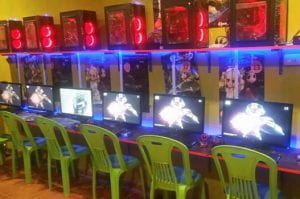A few years ago, in the small city of Sucre, Bolivia, the news reported the story of a boy who had been missing and found in a cyber cafe by his parents. He spent more than 48 hours in a row playing online games. In Bolivia, as in most Latin American countries, cybercafés are still very popular as they allow access to computers and internet since many do not have access to them at home. Although the number of cybercafés had declined in the residential areas of Bolivian cities, many can still be found in poor areas. A characteristic of these places is precisely that their biggest consumers are minors. The news report about the lost boy also explains that the cybercafé where he was found even offered mattresses and quilts to the children so they could rest for a while. One of the reports ends by stating that the authorities of Sucre would have taken actions on the matter since it was something illegal.
The idea of escapism has drawn my attention a lot since at first sight it seems to be a phenomenon whose only spur would be a recognizable crisis. However, escapism is a fundamental part of contemporary culture. Wherever we see, video games, cinema, literature, art, there is escapism. But, what is the crisis that is leading to this general escapism ? Starting from this question, which queries a broader framework than the current crisis that societies are going through due to Covid, I am interested in approaching the culture of escapism and its offer of evasion.
As you can see in this video, early in the 1990s, in cities like Santa Monica, cybercafés were a phenomenon embedded in a futuristic imagination. The video is interesting because it suggests that there is a poetics of those spaces related to the future and computers: the decoration of the cafes, even the new internet-related jargon of the young people would emphasize it. What is now obsolete in countries with greater access to personal computers and home internet such as the United States is presented as new and exciting in the video. However, some of those poetics can still be identified in the interiors of some of the cybercafés that continue to operate in Latin American cities, such as this one, in the city of Lima.
The neon color tones, the lights of the machines, the futuristic / Asian imagery of videogames imprinted on the walls at the back of the room, all these details evoke futurism. Obviously, the difference between the experience of the Californian cybercafé and the Peruvian one is radically different. The furniture of the former is much more solid, and the business of computers is parallel to that of the coffee shop. In that sense, its futuristic decoration seems to be closer to the American thematic decoration of traditional restaurants rather than a pure futuristic mise en scène. On the other hand, in the image of the Peruvian cybercafé, what stands out the most is the lack of strength of its furniture. It is an improvised business opened to satisfy the unstable market demand: the chairs and tables where the processors are placed have been so easily deployed that they can also be easily removed, in case of failure or upgrades. Even, as seen in this other photo of a Bolivian cybercafé, the internal architectural structure adds the feeling of improvised space.
But although both the American and South American experience of these spaces are very different and even contrary in their materiality, both spaces share their quality of being escape zones. One of the users of the Californian cybercafé says it clearly, “instead of going home or going to a bar, I come here to chat with my friends”, while, on the other hand, the news of the boy from Sucre also confirms it. But escape from what? The central argument of this visual essay is that indeed escapism has to do with crisis, but, contrary to the crisis effect produced by Covid, which is more noticeable due to its radical nature, the crisis to which a large part of contemporary escapism responds is that of neoliberal precariousness.
The Italian philosopher Franco Berardi defines “neoliberal precariousness” in this way:
Precariousness essentially means that every day we wake up knowing that a war is going to start again, a war to win our wages, to win our survival. Against whom? Not against the bosses, not against the exploiters, but against our companions, our lovers, our brothers, that means neoliberal precariousness.
Is not the story of the boy from Sucre symptomatic precisely of the need to avoid that awakening “knowing that a war is going to start again”? Most likely, the child has not been of working age, but the precariousness Berardi talks about is not only experienced by adults: the frustration, fear and anger produced by precariousness is also experienced within families.
As the gamers who read this text surely know, Cyberpunk 2077 is a first-person role-playing video game that will be released in September of 2020 and that surely will not take long to arrive through pirate versions to Third World´s cybercafés. Although the game has still not been released is very popular in the gamer community already. It is part of a role-playing franchise that appeared in the 80s and, as its Wikipedia entry indicates, it will star “a mercenary whose voice, face, hairstyles, body type and modifications, background, and clothing are customizable.” Located in Night City, a futuristic Californian city, this game embodies much of the imagination that has been built on a dystopian future the last 60 years: a post-apocalyptic world ruled by tyrannical hyper-technological powers, and urban areas infested with street crime, modified bodies, weapons and violence.
But while this game has not yet been released, about two years ago, memes in which the logo of the video game is inserted on supposedly “futuristic” images became very popular on social networks. The interesting and fun fact about these memes is that they reveal the complex nature of the dystopian fantasies that characterize the game and that are closely related to precariousness.
As can be seen in these two examples, part of the graphic repertoire of these memes relates to the children’s world in contexts in which a certain material precariousness, as in the first case, pushes people to find ingenious solutions that visually evoke futuristic images. In the second case, it is a comic image due to the visual coincidence between the child and science fiction characters. In the context of a cyber café, the materiality of the headphones, their colors and lights, makes them look like a respirator, and it is probable (therein lies the joke) that the child knows that this is so and he is playing with that idea.
But, if the escape is towards the fantasies of the future, what future is that to which Cyberpunk 2077 memes constantly parody? It is a precarious future, just as precarious as the present. That is why they are comic, that is why they are interesting. Escapist imaginations have been transforming over the last centuries, and it seems increasingly clear that although we dream of a future in which technology can modify our bodies, the world economy, and our ways of organizing society, it seems that we will never flee from precariousness. That is the content of escapist imagination in the context of the generalized crisis of neoliberal precariousness and that is also its paradoxical nature.
Further Research:
Hallan a Ñino Desaparecido en un Café Internet
Introducing the Crazy New World of Cybercafes
Franco ‘Bifo’ Berardi, “Suicidio, Precariedad y Mutación Digital”





